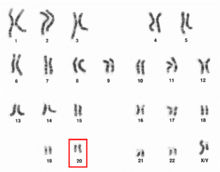Chromosome 20 (human)
| Chromosome 20 (human) | |
|---|---|
 Pair of human chromosome 20 (after G-banding). One is from mother, one is from father. | |
 Chromosome 20 pair in human male karyogram. | |
| Features | |
| Length (bp) | 63,025,520 bp[1] |
| Number of genes |
897 (NCBI) 1,068 (EBI) |
| Type | Autosome |
| Centromere position | Metacentric[2] |
| Identifiers | |
| RefSeq | NC_000020 |
| GenBank | CM000682 |

Chromosome 20 is one of the 23 pairs of chromosomes in humans. Chromosome 20 spans around 63 million base pairs (the building material of DNA) and represents between 2 and 2.5 percent of the total DNA in cells. Chromosome 20 was fully sequenced in 2001 and was reported to contain over 59 million base pairs representing 99.4% of the euchromatic DNA.[3] Since then, due to sequencing improvements and fixes, the length of chromosome 20 has been updated to just over 63 million base pairs.[1]
Identifying genes on each chromosome is an active area of genetic research. Because researchers use different approaches to predict the number of genes on each chromosome, the estimated number of genes varies. Depending on the genome annotation used, chromosome 20 contains 897 or 1,068 genes.[4][5]
Genes
The following are some of the genes located on chromosome 20:
- ADA: Adenosine Deaminase (Adenosine Deaminase Deficiency)
- AHCY: S-adenosylhomocysteine hydrolase
- ARFGEF2: ADP-ribosylation factor guanine nucleotide-exchange factor 2 (brefeldin A-inhibited)
- BMP2: Bone Morphogenetic Protein 2 (osteoblast differentiation)
- C20orf3: encoding protein Adipocyte plasma membrane-associated protein
- C20orf27: encoding protein UPF0687 protein C20orf27
- C20orf43: encoding protein UPF0549 protein C20orf43
- C20orf132: encoding protein Uncharacterized protein C20orf132
- DNAJC5: Cysteine string protein
- EDN3: endothelin 3
- GSS: glutathione synthetase
- GNAS1: Gs alpha subunit (membrane G-protein)
- JAG1: jagged 1 (Alagille syndrome)
- PANK2: pantothenate kinase 2 (Hallervorden-Spatz syndrome)
- PRNP: prion protein (p27-30) (Creutzfeldt–Jakob disease, Gerstmann-Strausler-Scheinker syndrome, fatal familial insomnia)
- tTG: tissue transglutaminase (auto antigen of Celiac disease)
- SALL4: sal-like 4 (Drosophila)
- VAPB: VAMP (vesicle-associated membrane protein)-associated protein B and C
Diseases and disorders
The following diseases are some of those related to genes on chromosome 20:[6]
- Albright's hereditary osteodystrophy
- Arterial tortuosity syndrome
- Adenosine deaminase deficiency
- Alagille syndrome
- Fatal familial insomnia
- Galactosialidosis - CTSA
- Maturity onset diabetes of the young type 1
- Neuronal ceroid lipofuscinosis
- Pantothenate kinase-associated neurodegeneration
- Transmissible spongiform encephalopathy (prion diseases)
- Waardenburg syndrome
References
- 1 2 "Homo sapiens chromosome 20, GRCh37.p13 Primary Assembly". National Center for Biotechnology Information. Retrieved October 17, 2013.
- ↑ "Table 2.3: Human chromosome groups". Human Molecular Genetics (2nd ed.). Garland Science. 1999.
- ↑ Deloukas P; et al. (2001). "The DNA sequence and comparative analysis of human chromosome 20". Nature. 414 (6866): 865–871. doi:10.1038/414865a. PMID 11780052.
- ↑ "Map Viewer". National Center for Biotechnology Information. Retrieved October 17, 2013.
- ↑ "Vega Genome Browser 54: Homo sapiens - Chromosome summary - Chromosome 20: 1-62,965,520". Wellcome Trust Sanger Institute. Retrieved October 17, 2013.
- ↑ Gilbert F (1997). "Disease genes and chromosomes: disease maps of the human genome". Genet Test. 1 (3): 225–229. doi:10.1089/gte.1997.1.225. PMID 10464650.
External links
| Wikimedia Commons has media related to Human chromosome 20. |
- Human Chromosome 20 Map Viewer — on NCBI